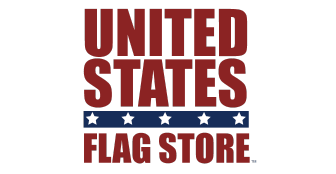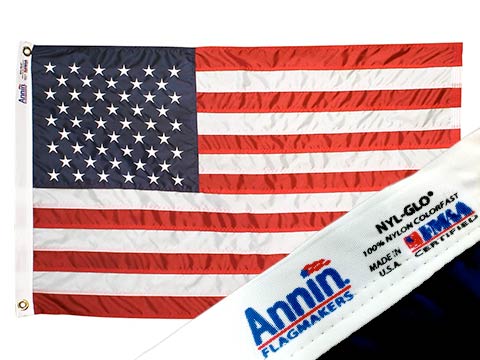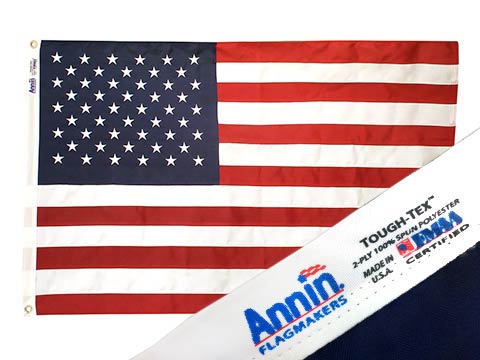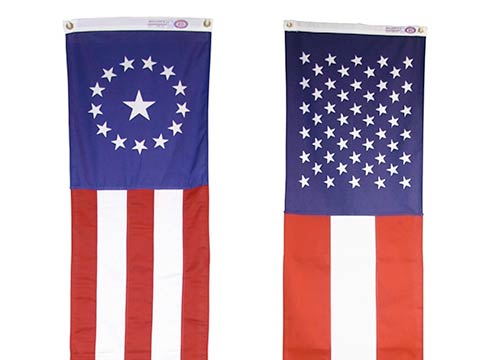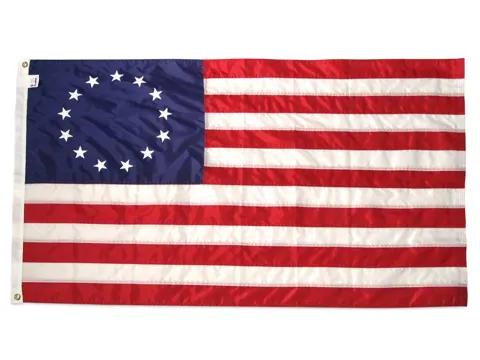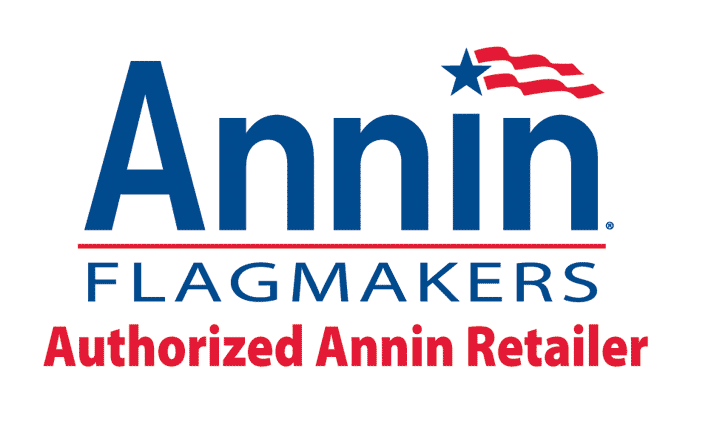
Annin American Flag Categories
Annin Flags
The History of Annin Flagmakers, An American-Made US Flag Company and their Impact on the Country
From Nautical Supplier to Flag maker
Starting with humble beginnings on Fulton St. in New York City, the roots of Annin Flagmakers run deep and have seen themselves take part in some truly notable events throughout American history. The company officially got its start in 1847 by Alexander Annin. Annin had been making flags and an array of other nautical supplies and equipment for merchant ships and yachts since the 1820s with his business as a ship chandlery. This was prime time for the then 23-year-old Alexander to open shop as the Erie Canal, a shipping highway between Lake Erie and the Hudson River had just opened up to the public in 1819. Over the following decades, business would only increase as New York became one of the largest hubs for commerce and ports for the shipment of goods from the East to the Midwest.
Becoming Annin and Co.
Alexander Annin would turn the business over to his two older sons, Edward and Benjamin shortly after starting the company in 1847. This is where the flag-making aspect of Annin Flagmakers would really take center stage and be the primary focus of the business. Before this, flags had only been one of the many items provided, with commercial and residential ships requiring a variety and hodgepodge of other products such as sailcloth, oils, and a handful of other tools needed to keep them afloat. The boys, Edward and Benjamin were 15 and 13 when they took over their father’s business, but Alexander would continue with managerial duties for the first few years. A younger brother, John, and Phebe Annin Ames Palmer—Alexander’s only daughter would also help in due time.
This would prove to be a significant time for the budding company in its newfound commitment to flags, as at the time, the United States was involved in an ongoing war with Mexico. Annin would be commissioned to make the flags for the fighting army.
Their dedication to their craft would pay off and word would spread of Annin's quality and service allowing them to supply the flag for the inauguration of President-elect of the United States of America, Zachary Taylor in 1849. They have since provided the flag for every presidential inauguration from then to the present day.
Global Recognition
The flag-making company would continue to grow and even become recognized and utilized on a global level. The first of their international commissions would happen the following year. Jenny Lind, a popular Swedish singer, and performer at the time, would embark on her national tour and enlist the company to supply flags for her. The tour would draw in hundreds of thousands of listeners who would now see Annin's flags.
In 1851, Queen Victoria and Prince Albert of Great Britain hired the company to make flags for the Queen’s “Great Exhibition of the Works of Industry of All Nations.” This event is considered to be the first in the World’s Fair Series.
The brother's younger John would finally come in to join the company during the 1950s.
The Civil War Era and Military Involvement
For the first time in U.S. history, the American flag would become a consumer item to the general public and not just used by the federal government or trade ships. With the start of the Civil War in 1861, both the Union and Confederacy wanted flags as well as the citizens who supported each side. Marian Calabro writes in Annin Flagmakers- An Illustrated History, "By the beginning of 1864, there was not a single battlefield, a brigade or a division [that did not use Annin flags] . . . whilst in the Navy—fighting ships and transports—they formed an equally brilliant and imposing decoration.” Annin sold 1.5 million flags and emblems during the war and sold their flags directly to the government with no formal written contract. Every city and state that supported the Union would want a flag.
Historical Notables
Carrying their tradition of supplying the inauguration flags to the President of the United States, Annin would do this for Abraham Lincoln as well. They would also subsequently provide the flag that had draped over his casket just 4 years later.
In 1883, Annin would provide the flags for the opening ceremonies of the Brooklyn Bridge.
They would also be the ones to supply Commander Robert E. Peary and his arrival at the North Pole in 1909.
Louis Annin Ames
Daughter Phebe Annin would marry Jacob Meech Ames, a southern boy with fields in South Carolina and offices in New York City. They lived off the Sea Islands near Charleston. She would give birth to Louis Annin Ames. Unfortunately, months later, Jacob would pass in a swimming accident and she would find herself moving back to Jersey City to be closer to family. It was with this event that Annin's history would carry on.
When Louis was 16, Phebe would eventually remarry. Louis went on to work at his stepfather's perfume factory, although he would not be staying for very long. Louis was offered a career with his Uncle John back in the family's flag-making business when his Uncle Benjamin passed in 1896. As his Uncle Edward had already retired and the other potential candidates of nephews and sons had turned this position down in lieu of their own ambitions and directions, Louis would be a clear candidate. This would be a fairly easy decision for Louis to make as his stepfather's company already had an heir and there would be slim chances of him moving up any farther within the ranks.
Louis Annin Ames would be an ambitious and giving leader within the company and industry. His approach was to give his employees the knowledge and opportunities to succeed and have them learn via a hands-on approach to get their know-how on flags. In 1906, Digby W. Chandler, a humble artist, and designer would join the team. Annin and Co. would become incorporated in 1910 and continue to make international flags for merchant ships as well as supplying wartime flags for both the Chinese Revolution and World War I. However, it was unknown that flags were being exported to China during this time as Chinese students from Columbia University had done this on their own accord and in secret.
By 1919, the company would build a state-of-the-art factory at 163 Bloomfield Avenue in Verona, NJ. It was dubbed a "building miracle," by Louis as this was erected in one of the coldest winters on record at the time. Equipped with spacious and well-lit grounds along with state-of-the-art lifts and elevators and Singer sewing machines that are still in use today.
The Boom and Collapse of the Flag Manufacturers
With their new model factory, Annin would continue to prosper well into the 1920s. This along with the natural boom of industrial and factory work led to more and more people moving from the farmlands and rural areas into cities and metropolitan areas. The country's wealth would double and women would finally get the right to vote during this time as well.
In 1923, Annin would make the then world's largest flag for the Detroit department store, J.L. Hudson. Designers had to figure out how to hang such a behemoth over the city block-long building and were able to do so by creating a scale model. The result was a flag that measured 90 feet by 200 feet and weighed in at a hefty 800 pounds. This flag would hold the largest flag in the world record until its retirement in 1946.
One year later in 1924, Chandler would be promoted to Vice President. This comes into pertinence 30 years later when Chanlder would eventually become the first nonfamily member to become President of the company.
Fulton Street would be sold in 1925 and Annin would relocate "Old Glory Corner," to Fifth Avenue. This had happened auspiciously as a chemical fire decimated most of the block nearly destroying the building just before their move. While no real correlation with the move, the fire still had a profound effect as Louis kept a clipping of the article in the newspaper years after the event.
Annin would supply flags to Rear Admiral Richard E. Byrd, an American naval officer and explorer who would take them with him to the South Pole. In 1929, Byrd would complete his first flight to the South Pole and back and would go on to have three separate Antarctic expeditions. He was also one of the first pilots to fly over not only the Atlantic Ocean but also the Arctic Ocean as well as to both the North and South Poles.
Unfortunately, due to the times and criminal activities within the organization, the company would file for bankruptcy in 1936. It was also around this time that Louis's son-in-law, C. Randolph Beard would join the company.
Revival and World War II
By 1938, Annin would successfully emerge from bankruptcy. This was in part thanks to the World Fair that had been held in New York City along with the beginning skirmishes of World War II. Although America hadn't been involved with the war until the day after the attack on Pearl Harbor, Hawaii, on December 7th, 1941, patriotism was still on the rise.
It would be during America's wartime, the company would be asked to do several interesting jobs. Some of these included making Japanese flags. These along with American flags would be used to take part in propaganda and cinematic films as well as being used in pro-America rallies and events. Annin would make approximately 350k American flags a month during the war.
In March of 1945, an Annin-made flag would fly atop Mt. Suribachi in Japan at the Battle of Iwo Jima. While done for the morale of the U.S. soldiers involved in the 35-day battle, the flag would also signal their eventual victory.
Following the War
By 1947, Annin would patent the development of a new fabric to make their flags. This would be a hybrid between nylon and wool. They used this material to make the World's largest free-flying flag on the George Washington Bridge. This flag measured 60 feet by 90 feet and clocked in at 500 pounds.
Louis Annin Ames would retire in 1950 with his grandsons, C. Randolph Beard II (Randy II), Carter Lee Beard (Lee), and John Dennis (Jack) becoming present in the company during the same decade.
Digby Chandler finally became president in 1952 nearly 50 years after his start and would be the first person from outside the family to do so.
Uptick with the Final Two States to join the Union
Alaska and Hawaii would finally be admitted into the Union in 1959, introducing the current version of the American flag with 50 stars. This flag was designed by Annin and would provide yet another boom for business.
Other Historical Notables in More "Recent," Years
An Annin-made flag was raised on Mt. Everest by the National Geographic Society in 1963.
Randy II took over the role of president in 1967.
By 1969, the flags of Annin took a trip to the moon on the Apollo 11 space mission and would take part in all following NASA missions.
Fifth Avenue finally closed its doors in 1969 when Annin would move their corporate offices to Verona, New Jersey.
The POW/ MIA flag saw its design and inception thanks to an artist at Annin's advertising agency, Newton Heisley in 1971.
Annin was given the honor of being the official flagmaker to the U.S. Bicentennial in 1976.
New developments in flag-making material become available with a 100% spun polyester that proved to be extremely durable. 1982 silk screening operations would also take place during this year.
George H.W. Bush used the Danco plant as a campaign stop for his 1988 presidential campaign.
The 9/11 terrorist attacks created an unrivaled demand for American flags in 2001. This would force the company to strategically implement its actions and manage the crisis caused by these unforeseen events.
By 2003, Annin became a founding member of the Flag Manufacturers Association of America.
A brand new state-of-the-art cellular sewing system was introduced in 2005 to Annin's Coshocton and South Boston plants.
South Boston again saw new technology in 2005 with the "Dream Machine," a digital fabric printer that mostly replaces silk screen printing.
In 2011, 6th generation family member, Carter Beard took over as president and CEO of Annin Flagmakers. Annin would also participate in the Field of Remembrance which took place at Battery Park, New York in celebration of the 10th Anniversary of September 11th.
2012 saw the purchase of a new digital flag printer, 3 times as fast as the "Dream Machine," and Annin established itself on Facebook.
Is Annin Flag Company still in business?
Annin Flagmakers are still in business and still making flags to the present day.
Where are Annin flags made?
Most of the flags sold by Annin Flagmakers are made right here in the United States except a handful that are imported from outside the country.
Where is Annin located?
The current corporate headquarters of Annin is located in New Jersey with 3 other state-of-the-art factories in Coshocton, Ohio, South Boston, Virginia, and Cobbs Creek, Virginia.
Are Annin flags made in the USA?
The vast majority of Annin Flags are made in the U.S.A.
Where to buy Annin flags?
The United States Flag Store is your one-stop, premier shop for all things flag and flag-related items with Annin flags right at the top of that list. Find your next Annin flag here today.
